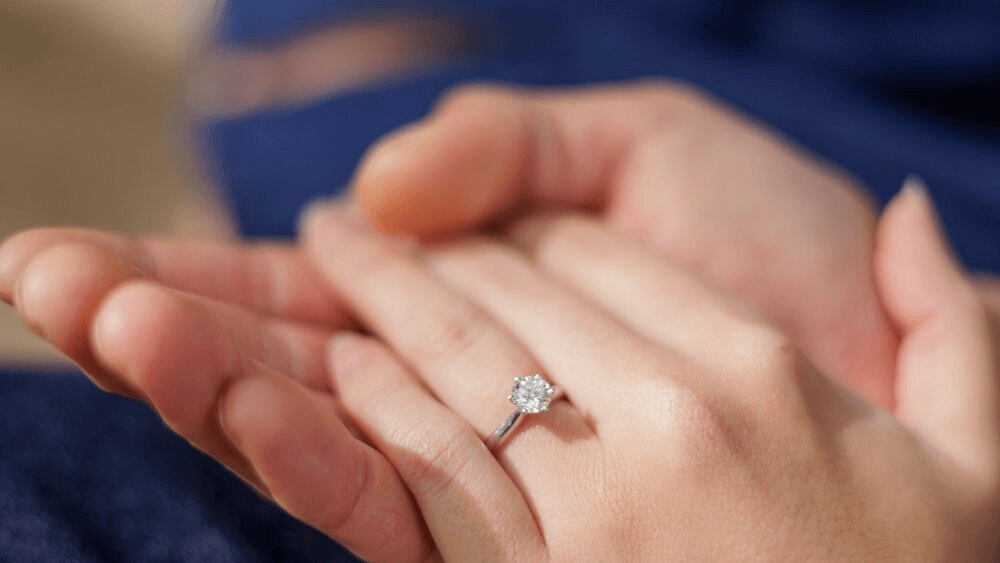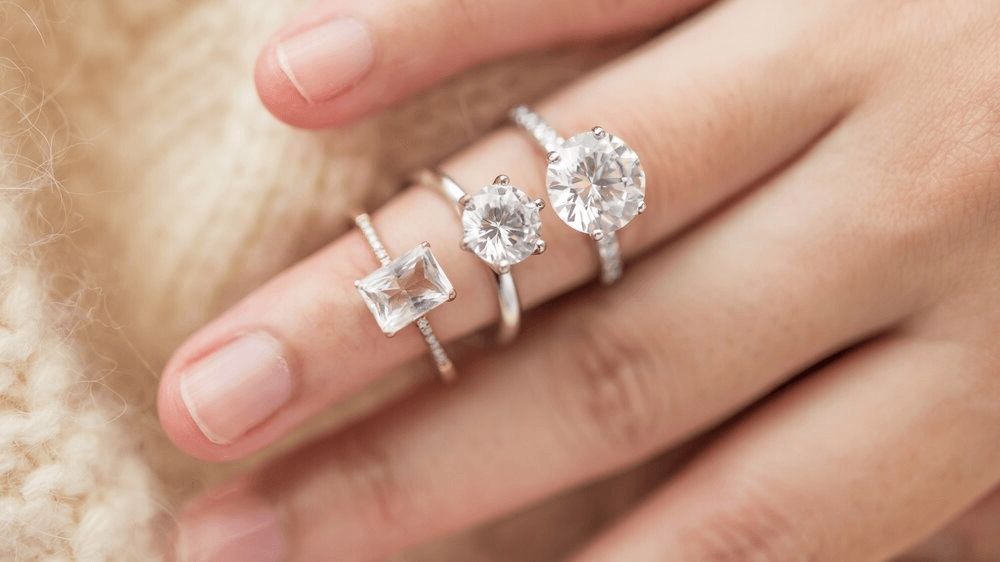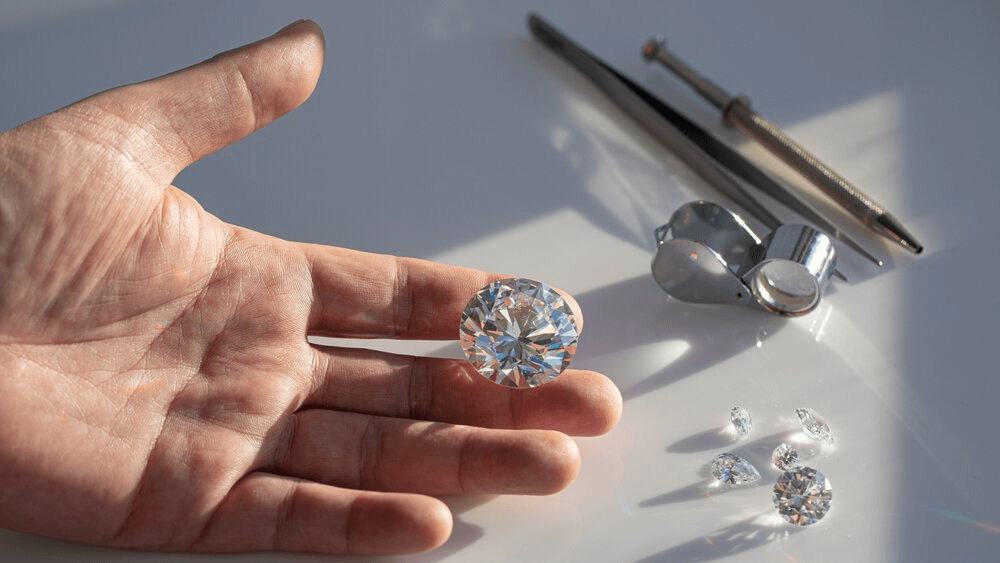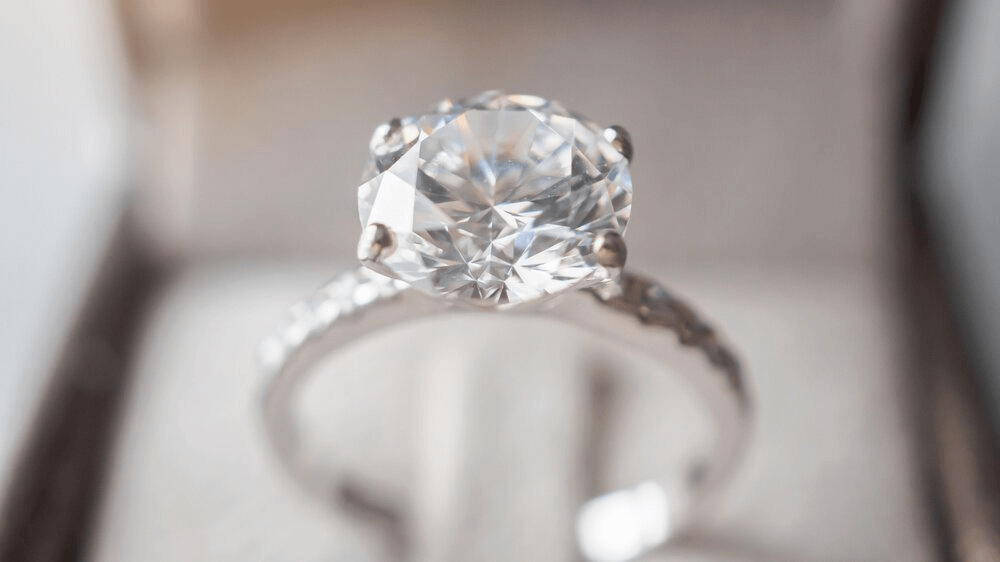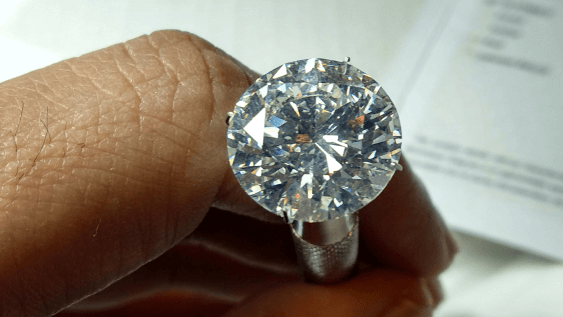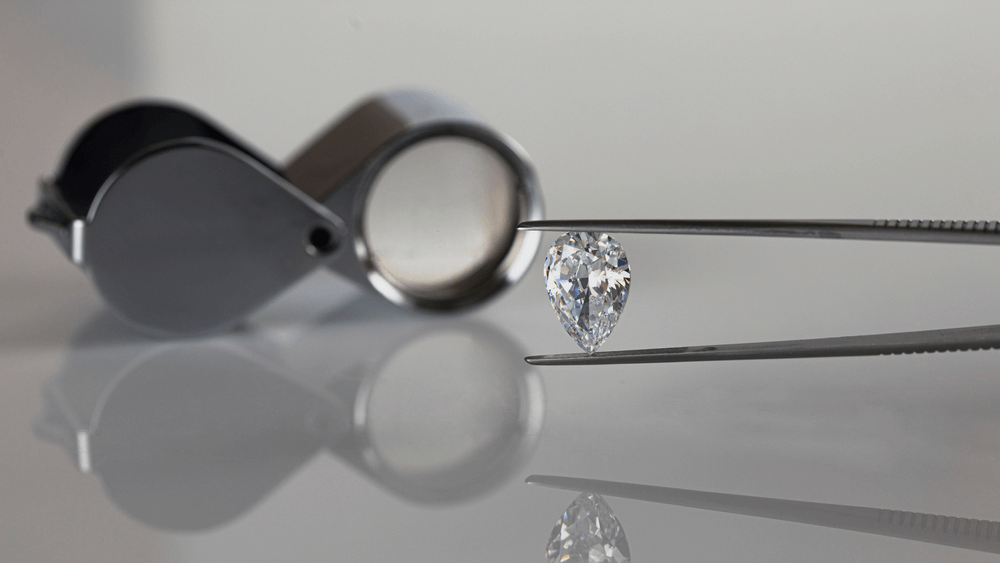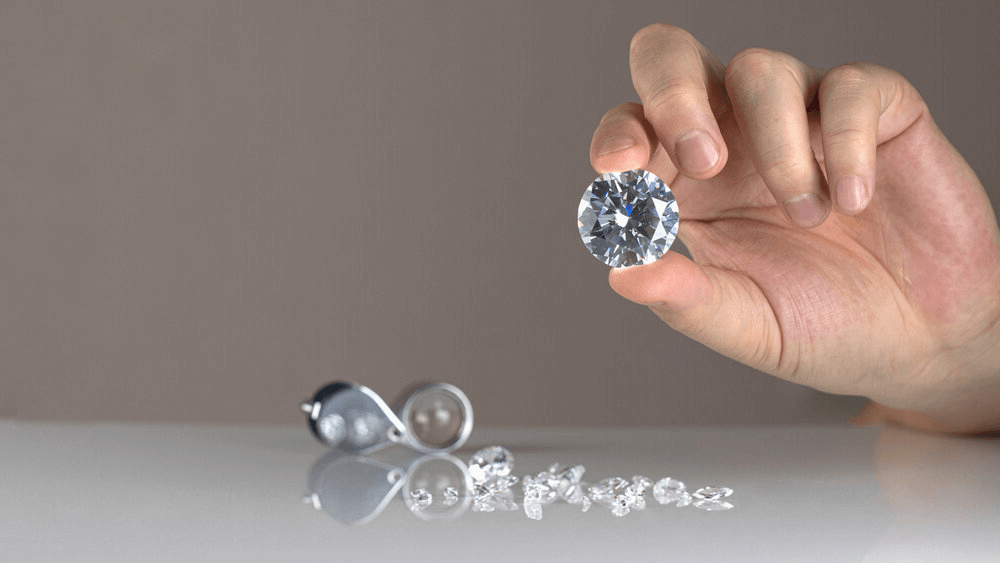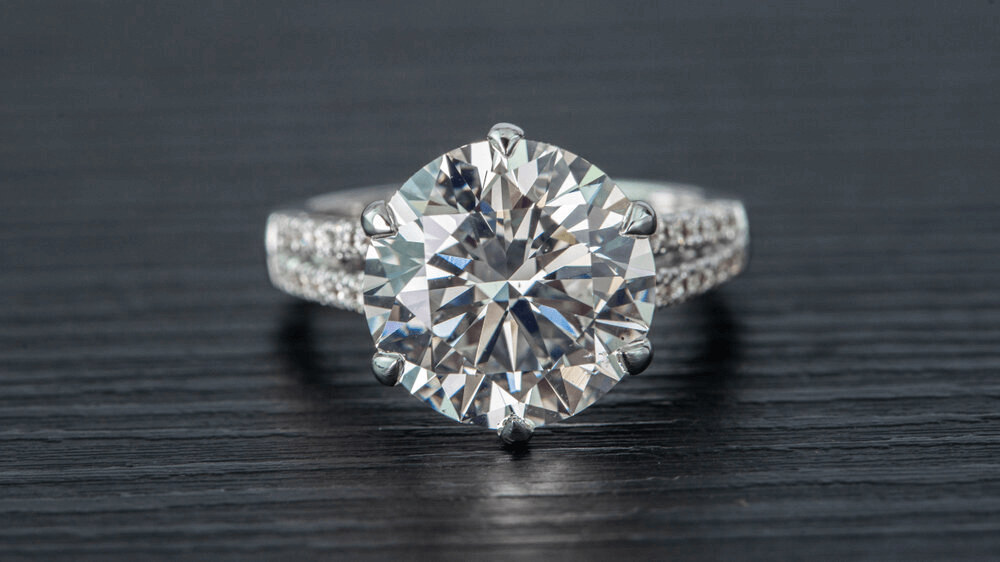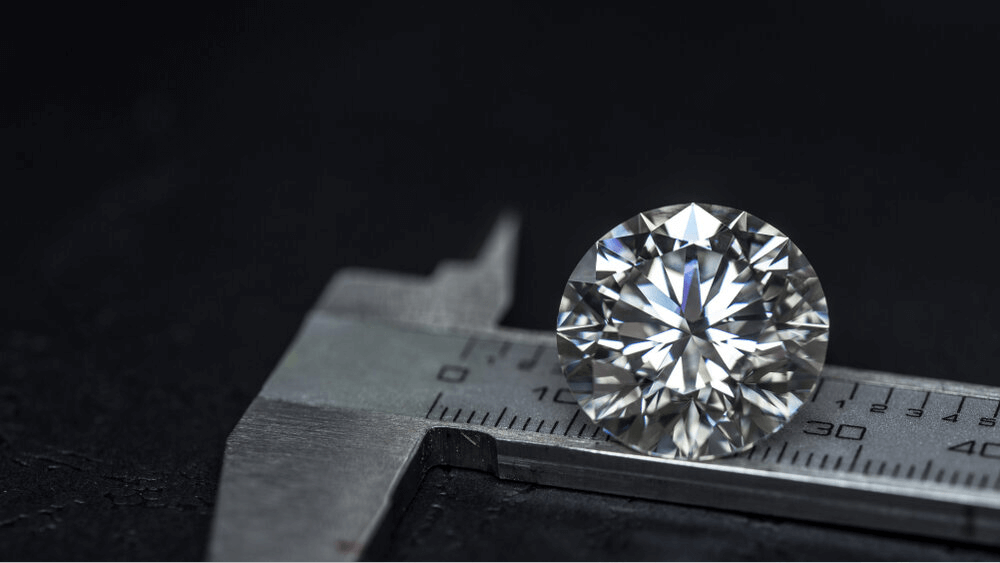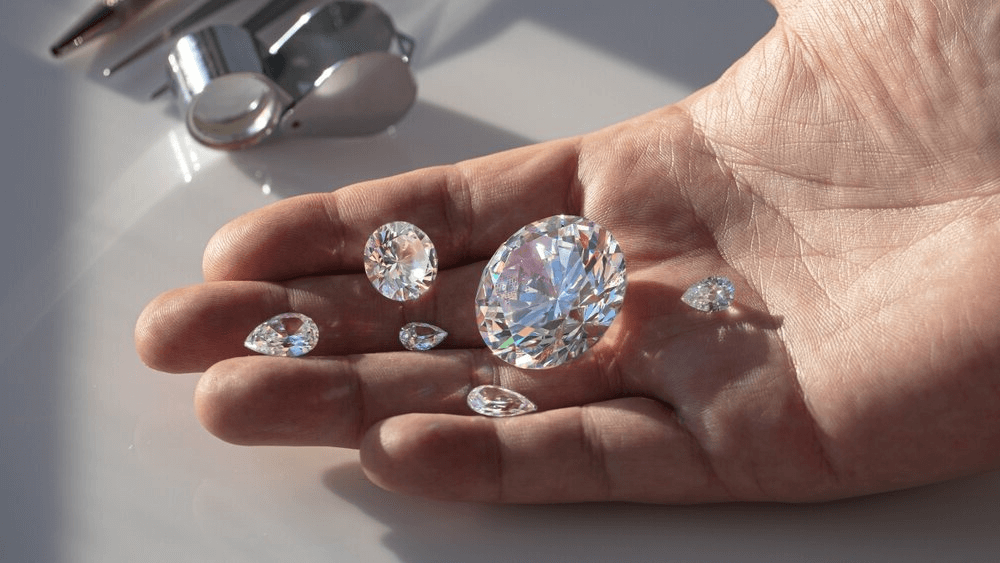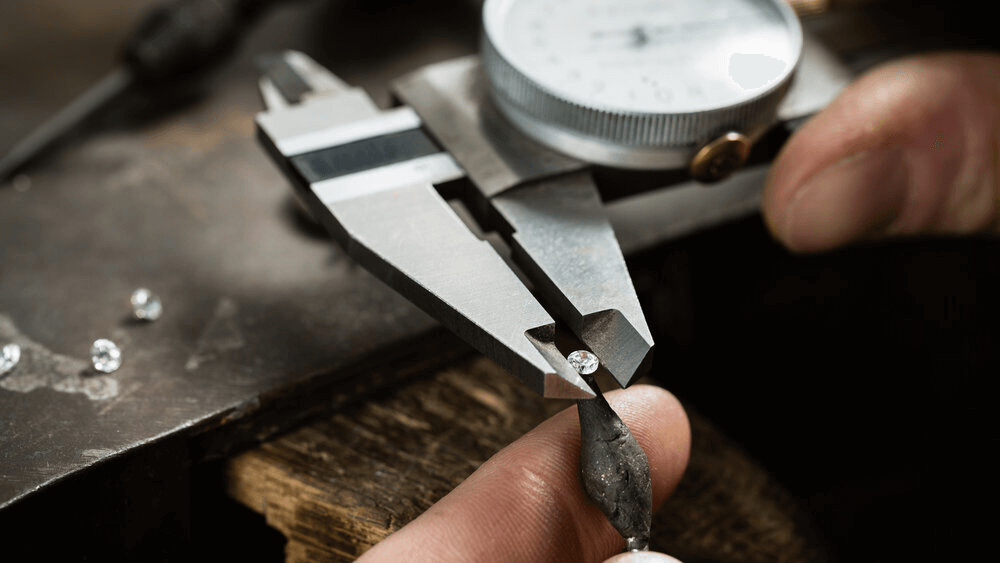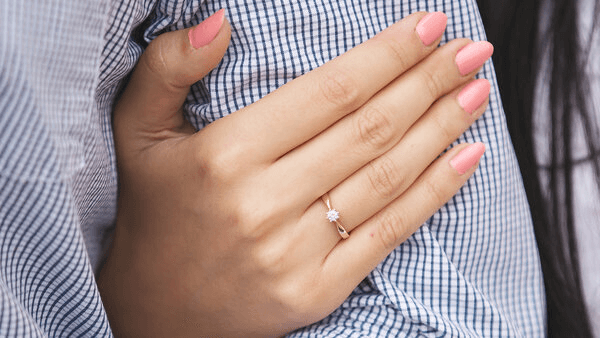Uncovering the 4-Carat Diamond Real Costs

By Gary A.

Edited by Olivia H.
Published Aug 8, 2022
Edited on Mar 31, 2025
When it comes to balancing elegance and size, a 4 carat diamond offers a dazzling choice that can truly make an engagement ring unforgettable.

- 9 Quick Tips for Buying a 4 Carat Diamond Engagement Ring
- Introduction
- The Lure of Size and Brilliance
- Four Carat Diamonds: Setting Expectations
- 4 Carat Diamond Rings
- Factors Influencing Diamond Ring Prices
- Natural vs Lab-Grown 4 Carat Diamonds
- Focusing on the 4 Carat Diamond Ring: Choosing the Right 4 Carat Diamond
- Our Expert Take
- 7 FAQs
Before we dive deeper into the specifics, here are some practical tips to help guide your decision-making process:
9 Quick Tips for Buying a 4 Carat Diamond Engagement Ring
- Tip 1: Understand the 4Cs: Cut, Color, Clarity, and Carat Cut: The cut determines the brilliance of the diamond. Even a high-carat diamond can look dull if poorly cut. Color: Consider the color grade; the less color, the more valuable. However, slight color variations can significantly reduce costs without compromising beauty. Clarity: Look for a diamond that is eye-clean. Inclusions and blemishes affect value but might not be visible to the naked eye. Carat: Remember, a 4 carat diamond is significant in size, but its overall beauty is also influenced by the other Cs.
- Tip 2: Compare Diamond Shapes and Cuts: Different shapes (round, oval, cushion) have varying price points. Some shapes make the diamond appear larger. Each shape interacts with light differently, affecting the diamond’s sparkle and perceived size.
- Tip 3: Assess the Diamond’s Certification: Ensure the diamond comes with a certification from a reputable lab like GIA or AGS. The certificate provides a detailed analysis of the diamond’s characteristics, ensuring you get what you pay for.
- Tip 4: Be Mindful of the Ring Setting: The setting can enhance the diamond’s appearance. A less expensive diamond might look more impressive in a well-chosen setting. Settings can also protect the diamond, an important consideration for a large 4 carat stone.
- Tip 5: Research Market Prices and Trends: Stay informed about the current market prices for 4 carat diamonds. Understanding trends can help you determine the best time to buy and get the most value for your money.
- Tip 6: Consider Future Resale Value: Although not a pleasant thought, consider the potential resale value. Some diamonds hold their value better than others. Classic cuts and shapes tend to have a more timeless appeal and may retain value better.
- Tip 7: Opt for a Slightly Larger Carat with Lower Clarity: Consider a 5 carat diamond with an SI1 clarity rating. These diamonds can offer significant savings and still appear flawless to the naked eye. SI1 diamonds have inclusions that are often invisible without magnification, making them a smart choice for those wanting a larger stone without a steep price increase.
- Tip 8: Choose a Lower Color Grade Within Reason: Select a diamond with a color grade around G. While not completely colorless, G-grade diamonds appear white and are less expensive than the highest color grades. In larger diamonds like 5 carats, slight color differences are more noticeable, but a G-grade can still offer a good balance between cost and appearance.
- Tip 9: Balance Size and Quality for Maximum Impact: A larger carat size with slightly lower clarity and color can make a more impactful statement than a smaller, higher-grade diamond. Ensure the cut is still of high quality, as this greatly influences the diamond’s brilliance and fire, making it appear more luxurious despite lower clarity or color grades.
Now that you’ve got these practical tips, use Jeweler AI below to find the perfect engagement ring that suits your style and budget:
Introduction
Planning a proposal is hard. From logistics to secrecy, photographers to – I don’t know…the flash mob(?) – there is a lot of ground to cover, and that’s before you can even begin to create the mental space necessary for figuring out the words you’ll say. When it comes to making your beloved starry-eyed with the romance of it all, we can’t offer much help beyond moral support, but we are firm believers in the old adage that if you can’t say it with words, say it with diamonds.
And, if you’re going to say it with diamonds – and you’ve got the budget behind you – why not say it with the biggest diamond possible? While a large rock isn’t a prerequisite for a happy marriage, there’s no denying the fact that bigger diamonds have some serious power.
The Lure of Size and Brilliance
A 4 carat diamond is a serious investment. The fascination shoppers and collectors feel for large, beautiful diamonds guarantees that, to get your hands on one, you’re going to have to pay some serious bucks.
There’s no universal cost for a 4 carat diamond, and what you pay will depend on a long list of variables. When you’re spending this much, you need to make sure that every little detail is right – and there are a lot of details to see. We’ll walk you through everything below.
Four Carat Diamonds: Setting Expectations
For a Round Brilliant 4 carat diamond cut to ideal proportions, the average diameter is approximately 10.2mm.
That measurement will differ significantly depending on the diamond’s shape since different cuts require weight to be distributed differently across the stone. Some shapes feature more weight above the girdle – for instance, the length of a 4 carat Oval diamond is around 12.8mm which gives the illusion of a weightier diamond – while others feature more weight below the girdle, where it won’t be seen once set within a ring.
The Cushion cut is a good example of this. At 4 carats, a Cushion will generally measure just over 9mm square, making it noticeably smaller than a Round Brilliant of the same weight.
When you’re homing in on 4 carat diamonds – or, for that matter, any size of diamond – you need to be very aware of the fact that ‘4 carat’ does not give any guarantees in terms of size. Yes, a 4 carat Cushion and a 4 Carat Oval represent the same amount of diamond, but that amount is distributed very differently between one shape and the next.
What’s more, poor quality cuts will distribute weight all wrong. An Oval that is cut too deep will appear a lot smaller when you look at its face-up appearance, whereas an Oval that is cut too shallow will appear a lot larger than the rest. If you think that sounds like a good trick, it’s not – you can read our guide to spready diamonds to find out why you absolutely, categorically don’t want one.
4 Carat Diamond Rings
Compared with your typical diamond engagement ring, a 4 carat diamond is definitely on the larger side! The average diamond purchased in the US for a proposal is a quarter of the weight at 1 carat – although, compared with the largest diamonds out there, 4 carats is still on the small side.
These super large, super rare diamonds are in the minority though, and nobody is going to look at your 4 carat engagement ring and say, ‘Yes it’s beautiful, but it’s not exactly the Cullinan, is it?’ If they do, we’d recommend making new friends.
The average size of a 1 carat Round Brilliant is 6.5mm, meaning a 4 carat Round Brilliant is just under 1.6 times the size of what ‘most people’ are wearing. It is, put simply, unmissably large. Even for onlookers who know very little about diamonds, it’ll be clear to see how much your choice surpassed expectations.
So, while a 4 carat diamond isn’t a rare marvel of nature, it is a real sight to behold – particularly on the finger of the love of your life.
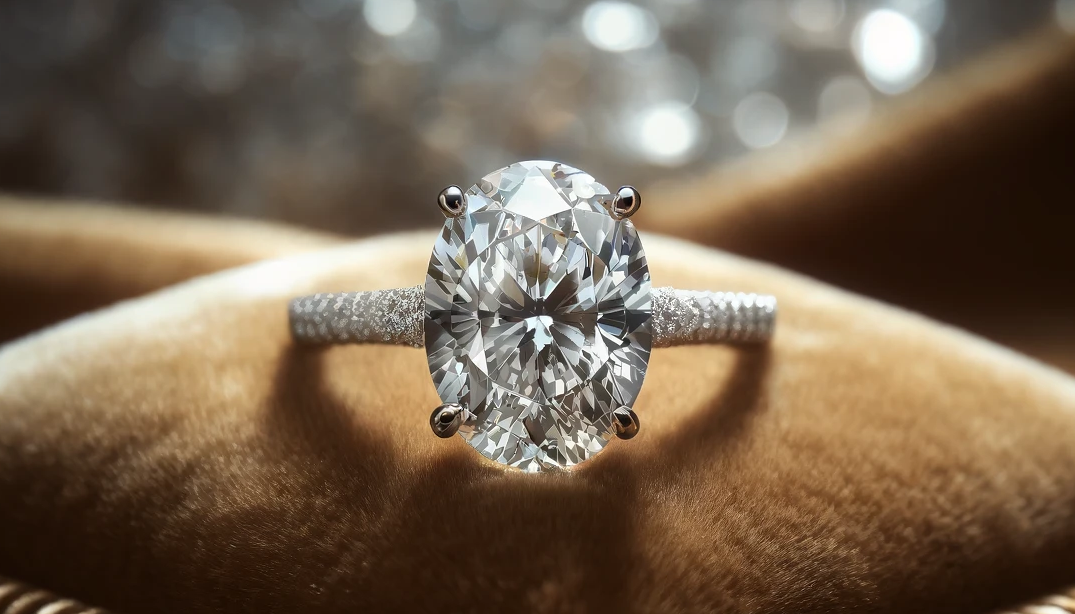
Factors Influencing Diamond Ring Prices
The average range goes from around $30,000, all the way up to $250,000 – or, in the case of a particularly sought-after and prestigious diamond, they could wind up going a lot higher.
The major difference in price between one 4 carat diamond and the next is down to quality. As we mentioned above, there are a lot of variables and details to see to when you’re choosing a diamond, and those variables are exactly what spells the difference between a five-figure price tag and a six-figure price tag.
The biggest mistake you could possibly make right now, however, is deciding that you’ll be able to find the perfect diamond at that lowest price point. These diamonds are priced significantly below what people are willing to pay for a reason, and, if you buy one, you will have to sacrifice some of the most important features and traits a beautiful diamond needs to have.
These diamonds do end up selling, primarily because some people set so much store by diamond size that they force themselves to overlook everything else – all those details we mentioned above.
For that reason, we’re going to walk you through each variable, how they drive the price up – how you can drive that price back down to a more comfortable level – and, ultimately, how you can make sure that the 4 carat diamond you walk away with is a true showstopper, worth every penny you spend on it.
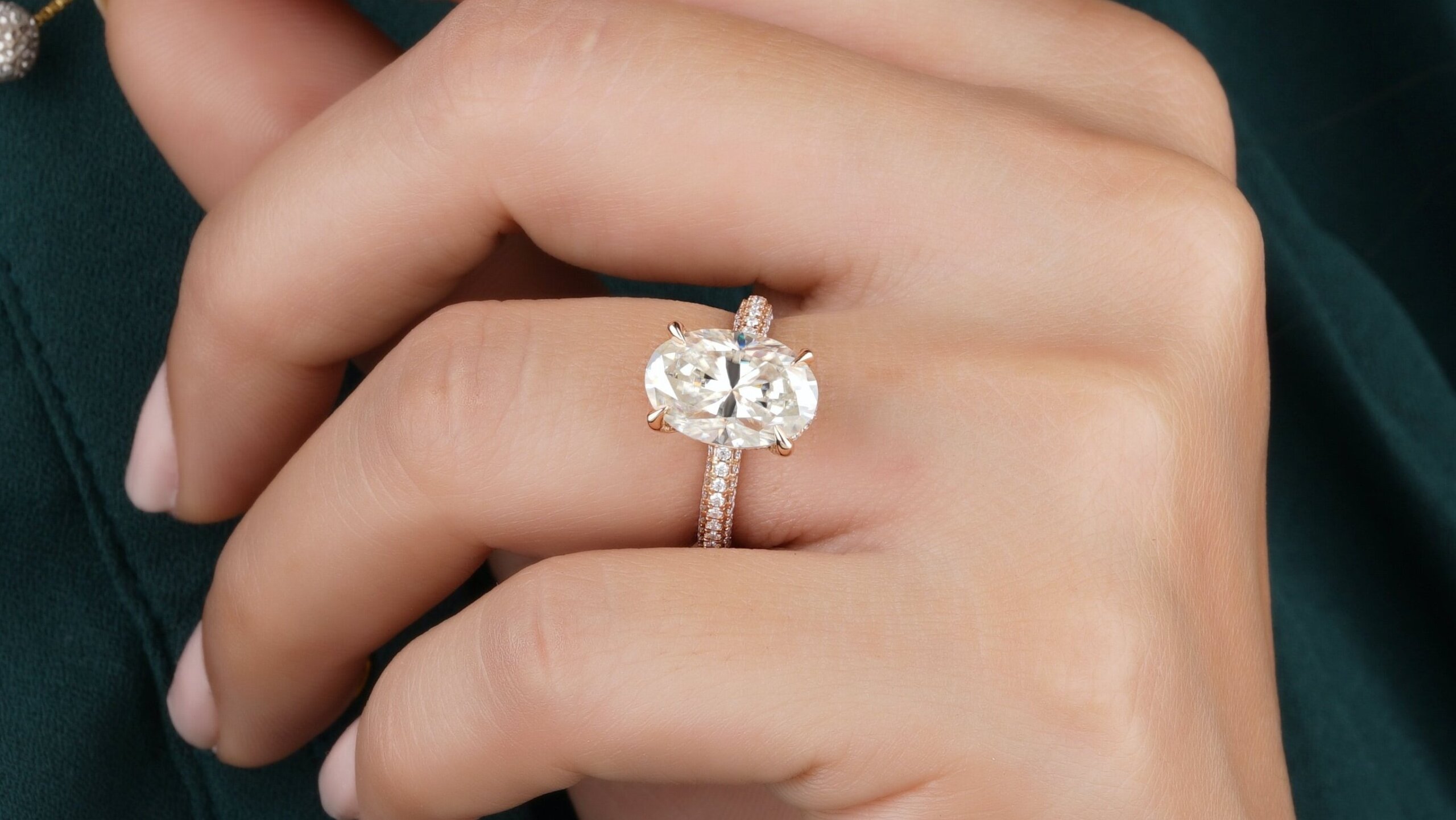
Natural vs Lab-Grown 4 Carat Diamonds
Choosing between natural and lab-grown 4 carat diamonds involves weighing value and personal preference.
Natural diamonds form over millions of years deep within the Earth, which adds to their allure and emotional significance. This rarity often results in a higher price tag, appealing to those who value tradition.
In contrast, lab-grown diamonds are created using advanced technology that replicates the natural process, making them more affordable and ethically sourced. They offer the same beauty and quality as natural diamonds, often at a lower cost.
Ultimately, the choice of natural vs. lab-grown comes down to personal values: whether you prioritize the legacy of a natural diamond or the ethical benefits of a lab-grown one. Both options can create stunning and meaningful engagement rings.
Here’s the table comparing the average prices of 4 carat natural diamonds versus lab-grown diamonds:
| Carat | Shape | Color | Clarity | Natural Price | Lab Grown Price |
|---|---|---|---|---|---|
| 4 carat | Round | F | VS2 | $110,000 | $9,600 |
| 4 carat | Pear | F | VS2 | $96,000 | $9,600 |
This table highlights the significant price difference between natural and lab-grown diamonds of the same carat weight and quality. For example, a 4 carat round diamond with F color and VS2 clarity costs approximately $110,000 as a natural stone, whereas its lab-grown counterpart is priced at just $9,600. Similarly, a pear-shaped diamond of the same specifications also sees a dramatic reduction in cost, from $96,000 for natural to $9,600 for lab-grown.
Focusing on the 4 Carat Diamond Ring: Choosing the Right 4 Carat Diamond
The Four Cs are the pillars of diamond quality. You need to understand each one, how it impacts a diamond’s appearance and performance, and how it impacts the overall cost of the diamond before you start to seriously think about investing in any stone.
The Four Cs system was devised by the GIA almost a century ago, and we still recommend that anyone shopping for a diamond only consider those that are accompanied by a full report from the GIA or AGS and not any other lab.
Balancing Quality with Budget in Your 4 Carat Diamond Ring
The VS grades are probably going to be your best bet. VVS1 and VVS2 come at a premium you don’t need to pay, but larger diamonds can rarely go lower than VS2.
For smaller diamonds, we often recommend shoppers start off looking as low as the SI1, SI2 and, at times, the I1 grade. But, as you start to look at bigger and bigger diamonds, you’ll find that the same clarity gradesthat worked before no longer offer the best results. The larger the diamond, the larger the table – and, unfortunately, the larger the table, the more chances there are that you’ll spot an inclusion.
But, whatever the size of your diamond, the rule is always the same: focus your search on eye clean diamonds, instead of a particular clarity grade. A single clarity grade can yield diamonds with very different appearances since clarity is graded under 10x magnification.
It would be very easy for us to tell you, ‘Buy a VS1 diamond’, but saying that would overlook the major differences in quality and value between one grade and the next. You could easily find a diamond that looks just as good (and for significantly less money) at the VS2 grade.
It’s possible that you could find a great 4 carat diamond at the SI1 grade, too, but definitely less likely given the size of the diamond.
This is why you can’t go off a report alone. You need to use the GIA’s clarity grade as a guide, but reaffirm what’s written within the report with an in-person, up close and personal appraisal of the diamond.
Our guide to checking eye cleanliness in diamonds will give you all the pointers you need.
Our Expert Take
A 4 carat engagement ring is a true crowd-pleaser. The extra investment required to get one of these diamonds on your partner’s finger will definitely pay off, and no one will be able to deny that that is a big and impressive rock on her finger.
Remember that, while big diamonds enjoy a very high status, they’re not the easiest things to wear (particularly at first), and some people find a more streamlined ring to be the more practical option for everyday life. It all depends on your partner, and you know better than us whether she will be thrilled by a big diamond, or by something a little less conspicuous.
As always, the key to making a good choice is to take your time, pick out a reputable jeweler who will lend their insight into the process, and do your research before you head in for your consultation. It really pays to know what you’re looking for (and what you’re not), and the best advice we can give you is to wait until you’re confident in your knowledge of the Four Cs, proportion and ratio, fluorescence, and eye cleanliness.
If you can get those subjects straight in your mind, then finding a 4 carat diamond will be a great experience for you, and for your future bride.
7 FAQs
- Q: What is the Average Price of a 4 Carat Diamond Ring?
A: The price of a 4 carat diamond ring can vary widely, typically ranging from $30,000 to $250,000, depending on factors like cut, clarity, color, and the ring setting. - Q: How Does the Cut Affect a 4 Carat Diamond’s Appearance?
A: The cut determines the diamond’s brilliance and fire. An excellent cut in a 4 carat diamond maximizes sparkle and can even make the diamond appear larger. - Q: Is a 4 Carat Diamond Considered Large for an Engagement Ring?
A: Yes, a 4 carat diamond is significantly larger than the average engagement ring diamond size, making it a luxurious and standout choice. - Q: Can You Notice Inclusions in a 4 Carat Diamond?
A: It depends on the clarity grade. Inclusions in SI1 or higher clarity diamonds are typically not visible to the naked eye, but lower clarity grades might have noticeable inclusions. - Q: How Does Color Grade Affect a 4 Carat Diamond’s Price?
A: Higher color grades (D-F) are more expensive. A G or H color grade can offer a balance of a white appearance and a more affordable price. - Q: Is it Better to Choose a Higher Clarity or Larger Carat Size?
A: This depends on personal preference and budget. Some prefer a larger stone with lower clarity, while others prioritize a smaller, more flawless diamond. - Q: Are 4 Carat Diamonds Good Investments?
A: While diamonds can retain value, they should primarily be chosen for their emotional and aesthetic value rather than as a financial investment.
Explore the true value of a 4 carat diamond with Jeweler AI – your expert guide in selecting the perfect engagement ring.
Here are more specific diamond prices topics to browse:
- Melee Diamonds: The Perfect Accents to Enhance the Center Stone
- Small Diamond Engagement Rings: Big Sparkle Comes In Little Packages
- 0.25 Carat Diamond: Tiny Treasure or Just Too Small?
- The True Value of a 0.5 Carat Diamond Ring Revealed
- 0.7, 0.8, 0.9 Carat Diamond Showdown: Which One Wins?
- Price Alert: Don’t Overpay for a 1 Carat Diamond Ring!
- What You Should Pay for a 1.5 Carat Diamond Ring?
- Price Alert: How Much Should You Pay for a 2 Carat Diamond Ring?
- How Much Does a 2.5 Carat Diamond Really Cost?
- The Real Cost of a 3 Carat Diamond Ring
- How Much is Too Much? The True Cost of 5 Carat Diamond Ring!
- 6 Carat Diamond Rings: Pricing Breakdown & Value Tips
- 7 Carat Diamond Rings: Affordable Luxury Prices Revealed
- 8 Carat Diamond Rings: Price Comparison & Savings Tips
- 9 Carat Diamond Rings: Detailed Pricing Guide & Best Deals
- 10-13 Carat Diamonds: The Ultimate Symbol of Luxury!
- 15 Carat Diamonds: Why Celebrities Love Them!
- Unveiling the Majesty: The Secrets Behind the 20 Carat Diamond Ring!
- Decoding the Grandeur: The Journey to Choosing a 25 Carat Diamond Ring
- Average Carat Size for Rings: What’s the Ideal?
- Understanding What Is CTTW Diamond In Engagement Ring
- The Truth About Why Diamonds Are So Expensive and Incredibly Valuable
FOLLOW-UP GUIDE SERIES

